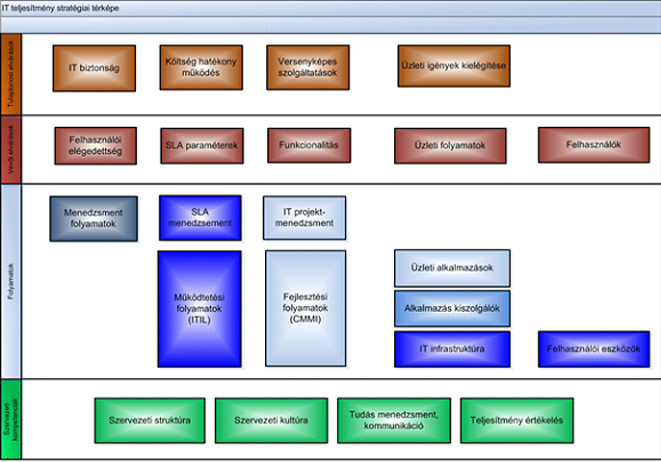Strategy Map
The strategy map concept became well-known as a component of the Balanced Scorecard method. Balanced Scorecard (acronym: BSC) is a strategic management tool (framework). While there exists a Hungarian translation of the term, the original English expression is just as widely used in Hungarian practice. Between 1992 and 2004, co-authors Robert S. Kaplan and David S. Norton published their views in 3 books (in Hungarian: Balanced Scorecard, Complex Kiadó Kft., 2004; A stratégia központú szervezet. (The Strategy Focused Organization), Panem Kft., 2002; Stratégiai térképek. (Strategy Maps), Panem Kft., 2005) and in a number of publications on the balanced scorecard system developed by them.
The term “balanced” means balancing between the indices of the four perspectives applied (financial, customer, internal business processes, learning and growth), which include, contrary to earlier practice, not only financial but other indicators as well resulting from objective and partly subjective measurements. The term “scorecard” refers to scorecards used in popular sports in the USA, that is, to quantified results.
Measures can be arranged along a strategic map, where the action chain among them can also be applied; in other words, their interdependencies can also be represented.
Despite the fact that it is primarily designed for the strategy development and implementation control of business organizations, it also came to be interpreted at levels of other than business companies and organizational units, including information technology.
The interpretation of the original perspectives needs to be modified in the design of an IT strategy map. IT organizations are not intended for profit generation, so classical financial measures cannot be applied directly. Owners’ expectations are preferably identified here in general, conveyed to the IT organization by corporate management.
Customers of the IT organization include internal customers working for the business areas of the company; their objectives are identified in the second dimension of the strategic IT map.
The third dimension identifies objectives related to internal business processes of the IT organization.
And the fourth perspective of learning and growth can include specifications of organizational capabilities, information management and technology development objectives.
The figure below shows a general IT strategy map. As it is a general map, it includes the areas to be studied in general, rather than specific objectives.

Identification and development of an IT strategy map is not only useful in the elaboration of a complete IT strategy, but also in surveys or diagnostics of problems in narrower areas.

